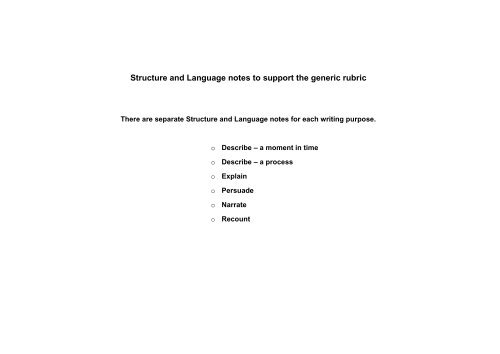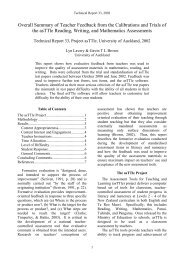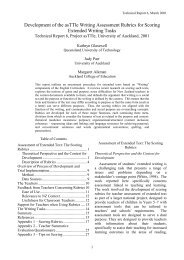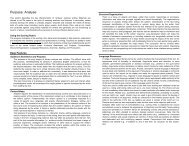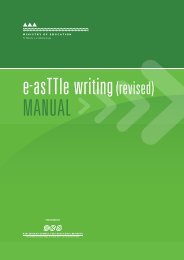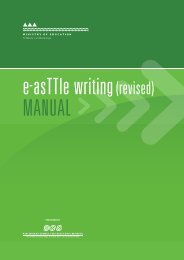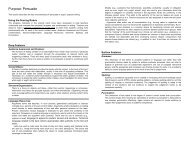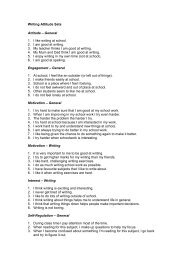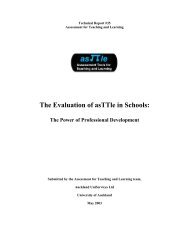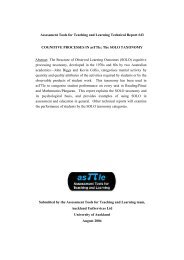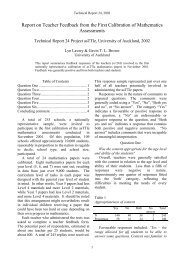Structure and Language notes to support the generic rubric - e-asTTle
Structure and Language notes to support the generic rubric - e-asTTle
Structure and Language notes to support the generic rubric - e-asTTle
You also want an ePaper? Increase the reach of your titles
YUMPU automatically turns print PDFs into web optimized ePapers that Google loves.
<strong>Structure</strong> <strong>and</strong> <strong>Language</strong> <strong>notes</strong> <strong>to</strong> <strong>support</strong> <strong>the</strong> <strong>generic</strong> <strong>rubric</strong><br />
There are separate <strong>Structure</strong> <strong>and</strong> <strong>Language</strong> <strong>notes</strong> for each writing purpose.<br />
o Describe – a moment in time<br />
o Describe – a process<br />
o Explain<br />
o Persuade<br />
o Narrate<br />
o Recount
<strong>Structure</strong> <strong>and</strong> <strong>Language</strong> Notes: Describe a moment in time<br />
Use <strong>the</strong>se <strong>notes</strong> when scoring writing against <strong>the</strong> categories for structure <strong>and</strong> language. The <strong>notes</strong> provide guidance on structural <strong>and</strong> language features that you<br />
might look for in <strong>the</strong> writing. They are not intended as a definitive list: o<strong>the</strong>r features may be used effectively <strong>to</strong> <strong>support</strong> <strong>the</strong> overall purpose of describing a moment in<br />
time.<br />
Prompts : • Adult <strong>and</strong> child • Girl • The market • Stick insect • Dogs at <strong>the</strong> beach<br />
Purpose To describe a moment in time<br />
… using a colour pho<strong>to</strong>graph as a prompt<br />
Structural features Orientation – an opening statement/s that provides <strong>the</strong> reader with a clear idea of what <strong>the</strong> text will be about, <strong>and</strong>/or that engages <strong>the</strong> reader’s<br />
interest<br />
Body – description of key aspects of <strong>the</strong> pho<strong>to</strong>graph that gives <strong>the</strong> reader a sense of ‘being <strong>the</strong>re’<br />
Ending – a closing statement/s that draws <strong>the</strong> writing <strong>to</strong> a satisfac<strong>to</strong>ry conclusion<br />
<strong>Language</strong> features Present tense 1 – timeless<br />
Expressive vocabulary – vivid, lively <strong>and</strong>/or emotive words <strong>and</strong> terms 2<br />
<br />
<br />
<br />
<br />
Descriptive detail that draws on a range of senses (sight, smell, sound, <strong>to</strong>uch) <strong>to</strong> create a vivid image OR<br />
Technical detail, if <strong>the</strong> student chooses <strong>to</strong> write a scientific description (e.g., stick insect)<br />
Objective/factual <strong>to</strong>ne OR<br />
Subjective/informal <strong>to</strong>ne that draws reader in<strong>to</strong> <strong>the</strong> scene<br />
1 Some texts may also include <strong>the</strong> past tense, e.g., if background events <strong>to</strong> <strong>the</strong> moment in time are included or if <strong>the</strong> text is actually a narrative or a recount. Use of <strong>the</strong><br />
past tense is acceptable if it does not interfere with <strong>the</strong> purpose – <strong>to</strong> describe. Note that, if <strong>the</strong> text is a narrative or a recount, <strong>the</strong> structure <strong>and</strong> language category is<br />
unlikely <strong>to</strong> be higher than R2.<br />
2 Look for <strong>the</strong> presence of appropriate vocabulary only. The quality/precision of word choice is assessed separately in <strong>the</strong> vocabulary aspect.
<strong>Structure</strong> <strong>and</strong> <strong>Language</strong> Notes: Describe a process<br />
Use <strong>the</strong>se <strong>notes</strong> when scoring writing against <strong>the</strong> categories for structure <strong>and</strong> language. The <strong>notes</strong> provide guidance on structural <strong>and</strong> language features that you might look for<br />
in <strong>the</strong> writing. They are not intended as a definitive list: o<strong>the</strong>r features may be used effectively <strong>to</strong> <strong>support</strong> <strong>the</strong> overall purpose of describing a process.<br />
Prompts : • The life cycle of Monarch butterflies • A frog life cycle<br />
Purpose To describe a process<br />
… using a labelled diagram of a life cycle<br />
Structural features Orientation – an opening statement/s that provides <strong>the</strong> reader with a clear idea of what <strong>the</strong> text will be about, <strong>and</strong>/or that engages <strong>the</strong> reader’s<br />
interest<br />
Body – sequenced description of process, with appropriate detail<br />
Ending – a closing statement/s that draws <strong>the</strong> writing <strong>to</strong> a satisfac<strong>to</strong>ry conclusion<br />
<strong>Language</strong> features Present tense 3 – timeless<br />
Verbs that denote actions (e.g., turns, grows, swims) 4<br />
<br />
<br />
<br />
Linking words showing logical relationships (time <strong>and</strong> sequence, cause <strong>and</strong> effect)<br />
Technical/factual detail<br />
Objective/logical <strong>to</strong>ne<br />
3 Some descriptions may be written in <strong>the</strong> future tense, e.g., <strong>the</strong> froglet will turn in<strong>to</strong> a frog. Use of <strong>the</strong> future tense is acceptable if it does not interfere with <strong>the</strong> purpose: <strong>to</strong><br />
describe <strong>the</strong> life-cycle process.<br />
4 Look for <strong>the</strong> presence of appropriate vocabulary only. The quality/precision of word choice is assessed separately in <strong>the</strong> vocabulary aspect.
<strong>Structure</strong> <strong>and</strong> <strong>Language</strong> Notes: Explain<br />
Use <strong>the</strong>se <strong>notes</strong> when scoring writing against <strong>the</strong> categories for structure <strong>and</strong> language. The <strong>notes</strong> provide guidance on structural <strong>and</strong> language features that you might look<br />
for in <strong>the</strong> writing. They are not intended as a definitive list: o<strong>the</strong>r features may be used effectively <strong>to</strong> <strong>support</strong> <strong>the</strong> overall purpose of explaining.<br />
Prompts : • A community facility • Caring for planet Earth • A special place in <strong>the</strong> community • Good friends<br />
Purpose<br />
To explain<br />
Structural features Orientation – an opening statement/s that identifies <strong>the</strong> student’s choice of problem, place or facility <strong>and</strong>/or defines <strong>the</strong> <strong>to</strong>pic<br />
Body – points of explanation <strong>support</strong>ed by examples or factual information<br />
Ending – a closing statement/s that draws <strong>the</strong> writing <strong>to</strong> a satisfac<strong>to</strong>ry conclusion, for example by summarising <strong>the</strong> main points<br />
<strong>Language</strong> features Present tense – timeless 5<br />
Verbs that express specific actions (melt, flood, recycle)<br />
Words expressing logical relationships between ideas (if … <strong>the</strong>n/because/so)<br />
Objective/reasoned <strong>to</strong>ne 6<br />
Passive voice<br />
Nominalisation<br />
5 Note that use of past or future tenses might also be appropriate, depending on <strong>the</strong> nature of <strong>the</strong> text.<br />
6 Some texts may take an emotive stance <strong>to</strong> <strong>the</strong> subject matter. This is acceptable if it <strong>support</strong>s <strong>the</strong> purpose of <strong>the</strong> text – <strong>to</strong> explain. For example, students may select an<br />
emotive <strong>to</strong>ne <strong>to</strong> persuade readers of <strong>the</strong> severity of a problem, or <strong>the</strong> necessity for a particular community facility.
<strong>Structure</strong> <strong>and</strong> <strong>Language</strong> Notes: Persuade<br />
Use <strong>the</strong>se <strong>notes</strong> when scoring writing against <strong>the</strong> categories for structure <strong>and</strong> language. The <strong>notes</strong> provide guidance on structural <strong>and</strong> language features that you might look<br />
for in <strong>the</strong> writing. They are not intended as a definitive list: o<strong>the</strong>r features may be used effectively <strong>to</strong> <strong>support</strong> <strong>the</strong> overall purpose of persuading.<br />
Prompts: • It is wrong <strong>to</strong> fight • The referee is always right • Music is more important than sport<br />
Purpose To persuade<br />
Students present <strong>and</strong> justify an opinion, <strong>to</strong> persuade a reader <strong>to</strong> a point of view.<br />
Structural features Introduction – may give background information <strong>to</strong> <strong>the</strong> <strong>to</strong>pic <strong>and</strong>/or state <strong>the</strong> writer’s opinion<br />
Body – points in <strong>support</strong> of <strong>the</strong> writer’s opinion, with evidence <strong>and</strong>/or examples<br />
Conclusion – summarises <strong>the</strong> main points <strong>and</strong> restates <strong>the</strong> writer’s position. May include recommendations<br />
<strong>Language</strong> features Present tense – timeless 7<br />
<br />
<br />
<br />
<br />
<br />
<br />
<br />
Text connectives that help <strong>to</strong> structure <strong>the</strong> argument (e.g., firstly, secondly, moreover, on <strong>the</strong> o<strong>the</strong>r h<strong>and</strong>, so)<br />
Modal verbs (e.g., might, must, should, ought <strong>to</strong>)<br />
Conjunctions that show cause <strong>and</strong> effect (because, so, if … <strong>the</strong>n)<br />
Rhe<strong>to</strong>rical questions<br />
Nominalisation<br />
Passive voice<br />
Logical/rational <strong>to</strong>ne OR emotive <strong>to</strong>ne<br />
7 Note that use of past or future tenses might also be appropriate, depending on <strong>the</strong> nature of <strong>the</strong> text.
<strong>Structure</strong> <strong>and</strong> <strong>Language</strong> Notes: Narrate<br />
Use <strong>the</strong>se <strong>notes</strong> when scoring writing against <strong>the</strong> categories for structure <strong>and</strong> language. The <strong>notes</strong> provide guidance on structural <strong>and</strong> language features that you might look for<br />
in <strong>the</strong> writing. They are not intended as a definitive list: o<strong>the</strong>r features may be used effectively <strong>to</strong> <strong>support</strong> <strong>the</strong> overall purpose of narrating.<br />
Prompts : • I heard a whisper but no-one was <strong>the</strong>re • The day things started disappearing • The bush<br />
Purpose To narrate<br />
… a s<strong>to</strong>ry, using a written or visual scenario as a prompt<br />
Structural features Orientation – an opening statement/s that introduces <strong>the</strong> context: <strong>the</strong> participants (who), <strong>the</strong> setting (where) <strong>and</strong> <strong>the</strong> time (when)<br />
A series of actions or events leading <strong>to</strong> a complication – one or more problems that must be resolved<br />
Ending/resolution – in which <strong>the</strong> problem is resolved (happily or unhappily)<br />
<strong>Language</strong> features Characters with individual personalities <strong>and</strong> identities<br />
Use of dialogue<br />
Descriptive <strong>and</strong>/or figurative language 8<br />
<br />
<br />
<br />
<br />
Nouns related <strong>to</strong> <strong>the</strong> event – specific people, places <strong>and</strong> happenings<br />
Connectives showing time sequence (first, <strong>the</strong>n, next)<br />
Past tense (although may also use present or future tense, especially in dialogue)<br />
Choice of language features may create a mystery, action, horror, fantasy, romance, detective or adventure narrative<br />
8 Look for <strong>the</strong> presence of appropriate vocabulary only. The quality or precision of word choice is assessed separately in <strong>the</strong> vocabulary criterion.
<strong>Structure</strong> <strong>and</strong> <strong>Language</strong> Notes: Recount<br />
Use <strong>the</strong>se <strong>notes</strong> when scoring writing against <strong>the</strong> categories for structure <strong>and</strong> language. The <strong>notes</strong> provide guidance on structural <strong>and</strong> language features that you might look for<br />
in <strong>the</strong> writing. They are not intended as a definitive list: o<strong>the</strong>r features may be used effectively <strong>to</strong> <strong>support</strong> <strong>the</strong> overall purpose of recounting an event.<br />
Prompts: • Whānau <strong>and</strong> family time • Time with friends • What I did well<br />
Purpose To recount<br />
… a personal event<br />
Structural features Orientation – an opening statement/s that introduces <strong>the</strong> context: <strong>the</strong> participants (who), <strong>the</strong> event/place (what) <strong>and</strong> when it <strong>to</strong>ok place (when)<br />
Body – a sequence of events<br />
Personal comment or reflection (e.g., ‘I had a great day’)<br />
<strong>Language</strong> features Action verbs (climbed, played, swam)<br />
Past tense<br />
Connectives showing time sequence (first, <strong>the</strong>n, next)<br />
Nouns related <strong>to</strong> <strong>the</strong> event – specific people, places <strong>and</strong> happenings 9<br />
<br />
<br />
Descriptive or emotive terms<br />
Use of first person pronouns (I, we)<br />
9 Look for <strong>the</strong> presence of appropriate vocabulary only. The quality/precision of word choice is assessed separately in <strong>the</strong> vocabulary aspect.


